
Alvaro Sanchez
@asanchezlab.bsky.social
CSIC Professor and Principal Investigator of the Quantitative Biology group at IBFG in Salamanca. Previously at Yale EEB, CNB-CSIC. Our group works on building predictive models of biological teams. More information at www.sanchezlaboratory.weebly.com
Reposted by Alvaro Sanchez
Open Call for Expressions of Interest: become a Max Planck Director & redefine what’s possible in science! We offer scientific independence, long-term stable funding & exceptional infrastructure. Lead your own department & open new frontiers of research. Apply by 31 Oct 2025 → www.mpg.de/directors

Directors
The Max Planck Society offers Directors a unique platform for groundbreaking research and leadership in diverse scientific fields.
www.mpg.de
September 17, 2025 at 3:25 PM
Open Call for Expressions of Interest: become a Max Planck Director & redefine what’s possible in science! We offer scientific independence, long-term stable funding & exceptional infrastructure. Lead your own department & open new frontiers of research. Apply by 31 Oct 2025 → www.mpg.de/directors
Reposted by Alvaro Sanchez
Early-career researchers: want to run your own lab? 🌟Max Planck Research Groups offer 6+ years, up to €2.7M in funding, open-topic freedom, team support & tenure-track opportunities. Intrigued? 😃Apply by Oct 14, 2025! www.mpg.de/max-planck-r...

September 15, 2025 at 9:27 AM
Early-career researchers: want to run your own lab? 🌟Max Planck Research Groups offer 6+ years, up to €2.7M in funding, open-topic freedom, team support & tenure-track opportunities. Intrigued? 😃Apply by Oct 14, 2025! www.mpg.de/max-planck-r...
Reposted by Alvaro Sanchez
Antimicrobial Resistance (AMR) could cause 10 million deaths by 2050. At PLAS-FIGHTER, we are working to change this!
🔎 We study how plasmids spread resistance to open up new avenues for future containment and diagnostic strategies.
Find out more 👇
plasmidlab.es/project/
#AntibioticResistance
🔎 We study how plasmids spread resistance to open up new avenues for future containment and diagnostic strategies.
Find out more 👇
plasmidlab.es/project/
#AntibioticResistance

Project - Plasmidlab
PLAS-FIGHTER Exploiting plasmid-bacteria interactions to fight
plasmidlab.es
September 8, 2025 at 8:41 AM
Antimicrobial Resistance (AMR) could cause 10 million deaths by 2050. At PLAS-FIGHTER, we are working to change this!
🔎 We study how plasmids spread resistance to open up new avenues for future containment and diagnostic strategies.
Find out more 👇
plasmidlab.es/project/
#AntibioticResistance
🔎 We study how plasmids spread resistance to open up new avenues for future containment and diagnostic strategies.
Find out more 👇
plasmidlab.es/project/
#AntibioticResistance
Reposted by Alvaro Sanchez
New paper alert! 🚨
Plasmids promote bacterial evolution through a copy number-driven increase in mutation rate.
We combine theory, simulations, experimental evolution, and bioinformatics to demonstrate that mutation rates scale with plasmid copy number.
Let's dive in! 🧵👇
Plasmids promote bacterial evolution through a copy number-driven increase in mutation rate.
We combine theory, simulations, experimental evolution, and bioinformatics to demonstrate that mutation rates scale with plasmid copy number.
Let's dive in! 🧵👇

Plasmids promote bacterial evolution through a copy number-driven increase in mutation rate
Plasmids are autonomously replicating DNA molecules that stably coexist with chromosomes in bacterial cells. These genetic elements drive horizontal gene transfer and play a fundamental role in bacter...
www.biorxiv.org
July 22, 2025 at 9:38 AM
New paper alert! 🚨
Plasmids promote bacterial evolution through a copy number-driven increase in mutation rate.
We combine theory, simulations, experimental evolution, and bioinformatics to demonstrate that mutation rates scale with plasmid copy number.
Let's dive in! 🧵👇
Plasmids promote bacterial evolution through a copy number-driven increase in mutation rate.
We combine theory, simulations, experimental evolution, and bioinformatics to demonstrate that mutation rates scale with plasmid copy number.
Let's dive in! 🧵👇
Reposted by Alvaro Sanchez
Do plasmids evolve faster 🐇, slower 🐢, or just like chromosomes 🧬?
In our new paper, we tackled this question using theory, simulations, bioinformatics, and experiments!
👇 Check out all the details in Paula’s thread!
Hint: 🐇 (most of the time)
In our new paper, we tackled this question using theory, simulations, bioinformatics, and experiments!
👇 Check out all the details in Paula’s thread!
Hint: 🐇 (most of the time)
July 22, 2025 at 3:05 PM
Do plasmids evolve faster 🐇, slower 🐢, or just like chromosomes 🧬?
In our new paper, we tackled this question using theory, simulations, bioinformatics, and experiments!
👇 Check out all the details in Paula’s thread!
Hint: 🐇 (most of the time)
In our new paper, we tackled this question using theory, simulations, bioinformatics, and experiments!
👇 Check out all the details in Paula’s thread!
Hint: 🐇 (most of the time)
Reposted by Alvaro Sanchez
Check out my first PhD paper on between-species genetic interactions (intergenomic epistasis) with @cbank.bsky.social 🌿↔️🦠✨ We define intergenomic epistasis mathematically and highlight its potential in understanding co-evolution :)
Studying the genetic basis of ecological interactions with intergenomic epistasis
https://doi.org/10.1111/oik.10835
#GxGInteractions #SpeciesInteractions #CoEvolution #HostPathogenInteractions #Epistasis #EcoEvolutionaryDynamics
https://doi.org/10.1111/oik.10835
#GxGInteractions #SpeciesInteractions #CoEvolution #HostPathogenInteractions #Epistasis #EcoEvolutionaryDynamics

April 3, 2025 at 3:03 PM
Check out my first PhD paper on between-species genetic interactions (intergenomic epistasis) with @cbank.bsky.social 🌿↔️🦠✨ We define intergenomic epistasis mathematically and highlight its potential in understanding co-evolution :)
Reposted by Alvaro Sanchez
Seeing this published is even better than eating sweets! I am so happy and proud of whole @lisamaierlab.bsky.social, especially Lisa and @jdlcz.bsky.social who walked the funny/exciting/rocky road with me until the very end. Check it out!
#science #microbiome #health
www.nature.com/articles/s41...
#science #microbiome #health
www.nature.com/articles/s41...

Non-antibiotics disrupt colonization resistance against enteropathogens - Nature
Non-antibiotic drugs from a wide range of therapeutic classes can alter the ability of gut commensals to resist invasion by enteropathogens, a previously underappreciated side effect of such drugs.
www.nature.com
July 17, 2025 at 9:06 AM
Seeing this published is even better than eating sweets! I am so happy and proud of whole @lisamaierlab.bsky.social, especially Lisa and @jdlcz.bsky.social who walked the funny/exciting/rocky road with me until the very end. Check it out!
#science #microbiome #health
www.nature.com/articles/s41...
#science #microbiome #health
www.nature.com/articles/s41...
Reposted by Alvaro Sanchez
New paper in @nature.com! With @kiseokmicro.bsky.social , Siqi Liu, Kyle Crocker, Jojo Wang, Mikhail Tikhonov & Madhav Mani — a massive dataset and simple model reveal a few conserved regimes that capture how soil microbiome metabolism responds to perturbations. www.nature.com/articles/s41...

July 17, 2025 at 6:36 AM
New paper in @nature.com! With @kiseokmicro.bsky.social , Siqi Liu, Kyle Crocker, Jojo Wang, Mikhail Tikhonov & Madhav Mani — a massive dataset and simple model reveal a few conserved regimes that capture how soil microbiome metabolism responds to perturbations. www.nature.com/articles/s41...
Reposted by Alvaro Sanchez
This paper by Belda et al makes the case for wine fermentation as a model system in microbial ecology and evolution, one which hits a sweet spot between experimental tractability and rich ecological and evolutionary dynamics.
enviromicro-journals.onlinelibrary.wiley.com/doi/full/10....
enviromicro-journals.onlinelibrary.wiley.com/doi/full/10....
enviromicro-journals.onlinelibrary.wiley.com
July 16, 2025 at 2:58 PM
This paper by Belda et al makes the case for wine fermentation as a model system in microbial ecology and evolution, one which hits a sweet spot between experimental tractability and rich ecological and evolutionary dynamics.
enviromicro-journals.onlinelibrary.wiley.com/doi/full/10....
enviromicro-journals.onlinelibrary.wiley.com/doi/full/10....
Reposted by Alvaro Sanchez
This paper by Shraddha Karve discusses how evolutionary novelties emerge in microorganisms, focusing on the different types of novel traits and the role played by the environment.
enviromicro-journals.onlinelibrary.wiley.com/doi/10.1111/...
enviromicro-journals.onlinelibrary.wiley.com/doi/10.1111/...
enviromicro-journals.onlinelibrary.wiley.com
July 16, 2025 at 2:58 PM
This paper by Shraddha Karve discusses how evolutionary novelties emerge in microorganisms, focusing on the different types of novel traits and the role played by the environment.
enviromicro-journals.onlinelibrary.wiley.com/doi/10.1111/...
enviromicro-journals.onlinelibrary.wiley.com/doi/10.1111/...
Reposted by Alvaro Sanchez
This piece by Orr, Armitage & Letten provides a nice & clear introduction to modern coexistence theory for microbiologists, discussing how it can be applied to microbial communities & highlighting its promise, limitations & opportunities.
enviromicro-journals.onlinelibrary.wiley.com/doi/10.1111/...
enviromicro-journals.onlinelibrary.wiley.com/doi/10.1111/...
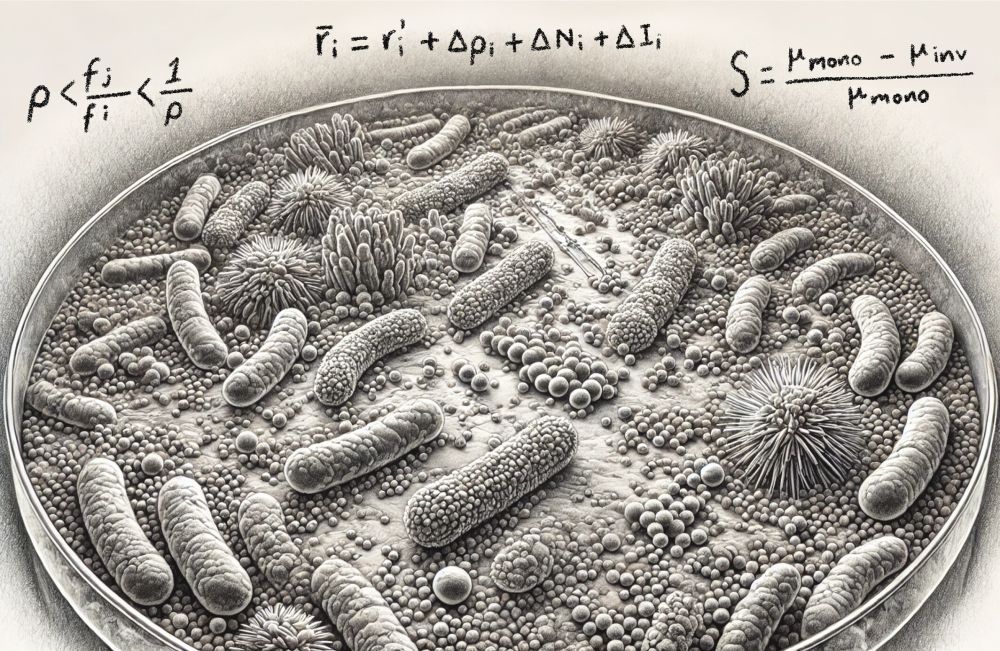
Coexistence Theory for Microbial Ecology, and Vice Versa
Classical models from theoretical ecology are seeing increasing uptake in microbial ecology, but there remains rich potential for closer cross-pollination. Here we explore opportunities for stronger ...
enviromicro-journals.onlinelibrary.wiley.com
July 16, 2025 at 2:58 PM
This piece by Orr, Armitage & Letten provides a nice & clear introduction to modern coexistence theory for microbiologists, discussing how it can be applied to microbial communities & highlighting its promise, limitations & opportunities.
enviromicro-journals.onlinelibrary.wiley.com/doi/10.1111/...
enviromicro-journals.onlinelibrary.wiley.com/doi/10.1111/...
Reposted by Alvaro Sanchez
This excellent article by @clsong.bsky.social synthesizes research on the Assembly Graph, a useful conceptual & methodological tool to understand the dynamic assembly of microbial communities and multispecies coexistence.
enviromicro-journals.onlinelibrary.wiley.com/doi/abs/10.1...
enviromicro-journals.onlinelibrary.wiley.com/doi/abs/10.1...
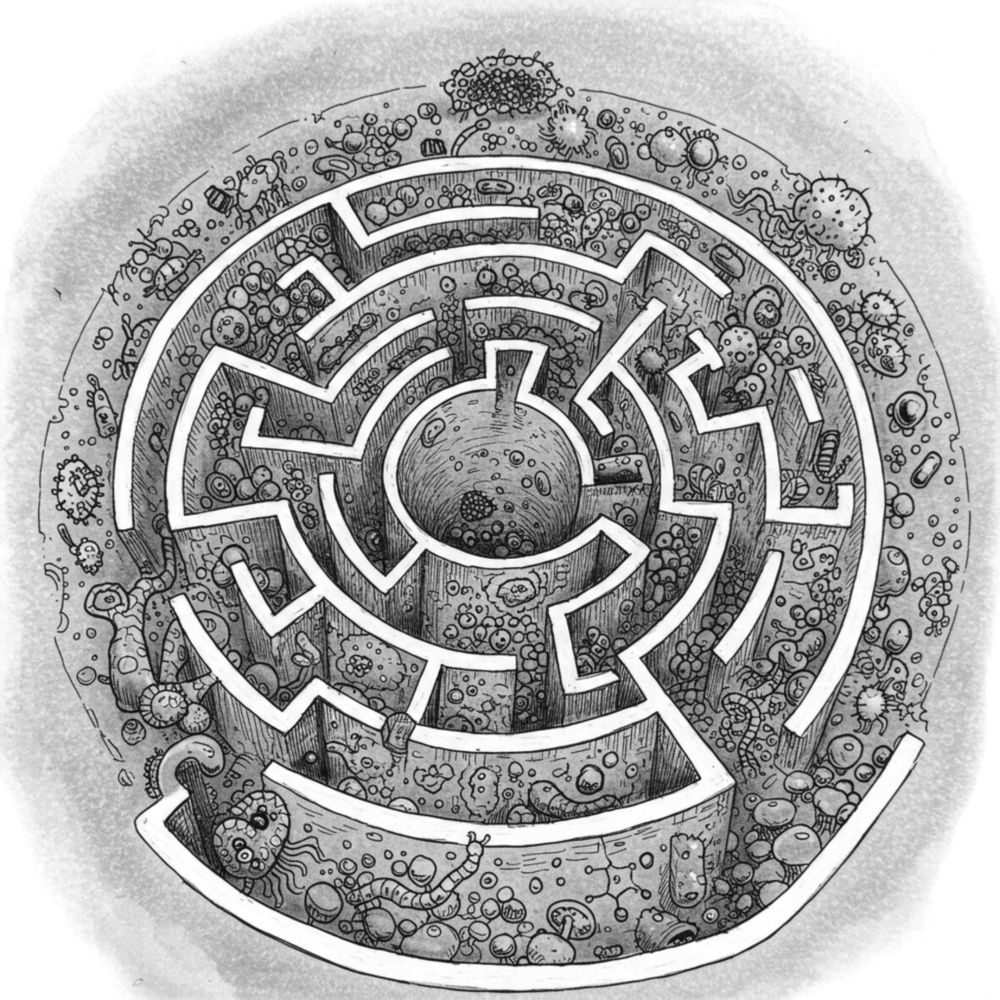
Assembly Graph as the Rosetta Stone of Ecological Assembly
This paper introduces the assembly graph as an integrative lens to unify ecological assembly theories across dynamical, informational, and probabilistic approaches. In addition to theory, it also pre....
enviromicro-journals.onlinelibrary.wiley.com
July 16, 2025 at 2:58 PM
This excellent article by @clsong.bsky.social synthesizes research on the Assembly Graph, a useful conceptual & methodological tool to understand the dynamic assembly of microbial communities and multispecies coexistence.
enviromicro-journals.onlinelibrary.wiley.com/doi/abs/10.1...
enviromicro-journals.onlinelibrary.wiley.com/doi/abs/10.1...
How may theoretical ecology & evolutionary theory push microbiology forward?
At Environmental Microbiology, I am commissioning a series of Perspectives exploring that question. Excited to share them in the 🧵 below
The series is open, so do get in touch if you'd like to propose a new contribution!
At Environmental Microbiology, I am commissioning a series of Perspectives exploring that question. Excited to share them in the 🧵 below
The series is open, so do get in touch if you'd like to propose a new contribution!
July 16, 2025 at 2:58 PM
How may theoretical ecology & evolutionary theory push microbiology forward?
At Environmental Microbiology, I am commissioning a series of Perspectives exploring that question. Excited to share them in the 🧵 below
The series is open, so do get in touch if you'd like to propose a new contribution!
At Environmental Microbiology, I am commissioning a series of Perspectives exploring that question. Excited to share them in the 🧵 below
The series is open, so do get in touch if you'd like to propose a new contribution!
Reposted by Alvaro Sanchez
New paper with @rwheatley8.bsky.social and Cedric Lood
Actual title: Chromosomal capture of beneficial genes drives plasmids towards ecological redundancy.
Sensationalist title: Plasmids carry useless genes
academic.oup.com/ismej/articl...
Actual title: Chromosomal capture of beneficial genes drives plasmids towards ecological redundancy.
Sensationalist title: Plasmids carry useless genes
academic.oup.com/ismej/articl...

Chromosomal capture of beneficial genes drives plasmids toward ecological redundancy
Abstract. Plasmids are a ubiquitous feature of bacterial genomes, but the forces driving genes and phenotypes to become associated with plasmids are poorly
academic.oup.com
July 16, 2025 at 9:17 AM
New paper with @rwheatley8.bsky.social and Cedric Lood
Actual title: Chromosomal capture of beneficial genes drives plasmids towards ecological redundancy.
Sensationalist title: Plasmids carry useless genes
academic.oup.com/ismej/articl...
Actual title: Chromosomal capture of beneficial genes drives plasmids towards ecological redundancy.
Sensationalist title: Plasmids carry useless genes
academic.oup.com/ismej/articl...
Reposted by Alvaro Sanchez
It was an honor and a joy to receive the National Research Prize for Young (!) Researchers. The highlight? My grandma greeting the King of Spain.
What a day!
www.youtube.com/watch?v=oSQP...
What a day!
www.youtube.com/watch?v=oSQP...
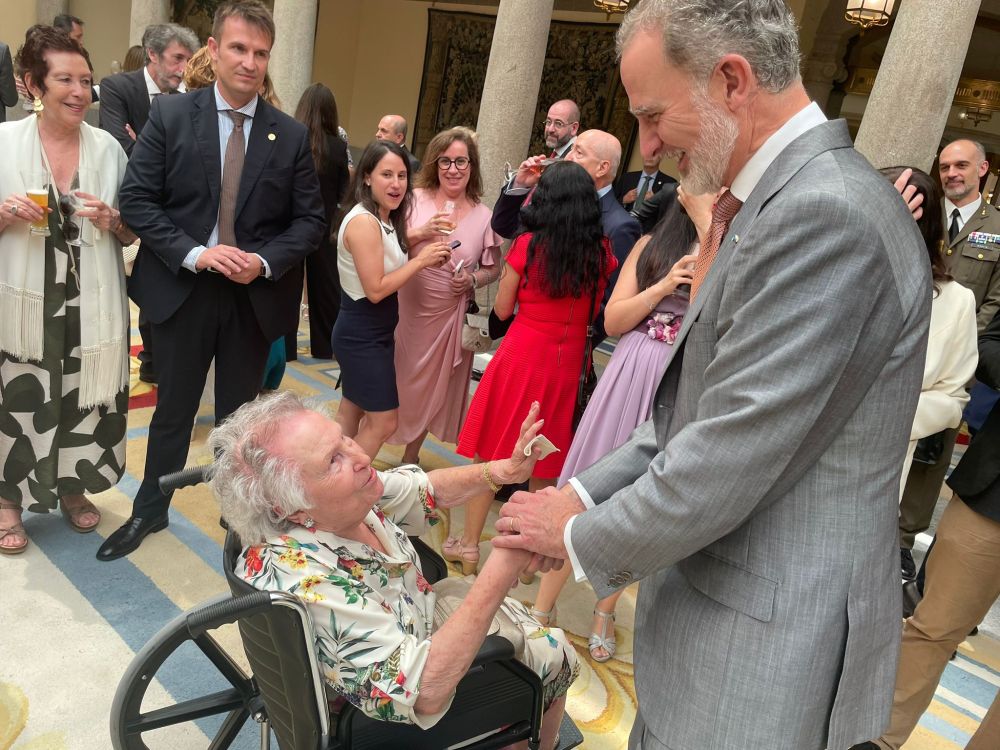
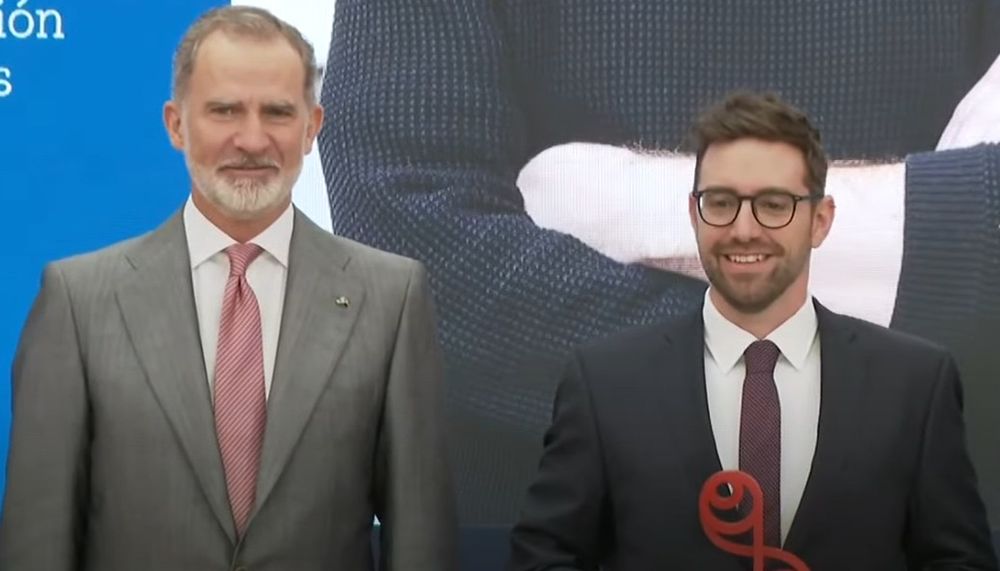
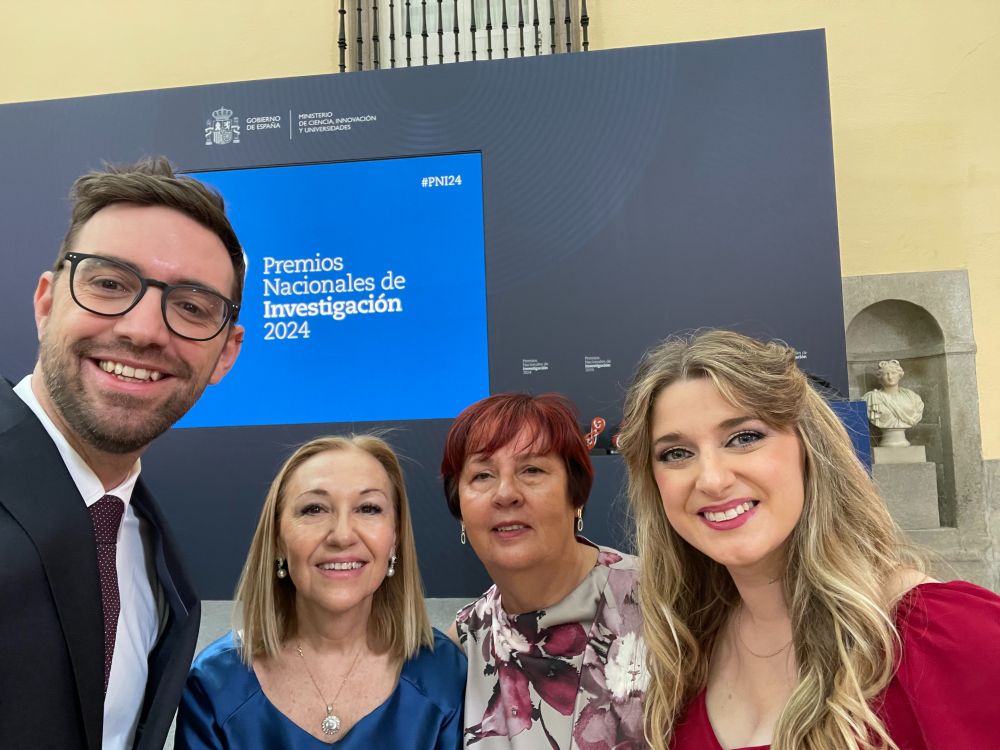
July 3, 2025 at 7:52 PM
It was an honor and a joy to receive the National Research Prize for Young (!) Researchers. The highlight? My grandma greeting the King of Spain.
What a day!
www.youtube.com/watch?v=oSQP...
What a day!
www.youtube.com/watch?v=oSQP...
Reposted by Alvaro Sanchez
🚨🚨New paper out in @natcomms.nature.com!!
Come for the first large-scale analysis of plasmid copy number across species,
stay for one of the most intriguing results of my lab: universal scaling laws in plasmid biology! 📈🧬
👉 www.nature.com/articles/s41...
Come for the first large-scale analysis of plasmid copy number across species,
stay for one of the most intriguing results of my lab: universal scaling laws in plasmid biology! 📈🧬
👉 www.nature.com/articles/s41...
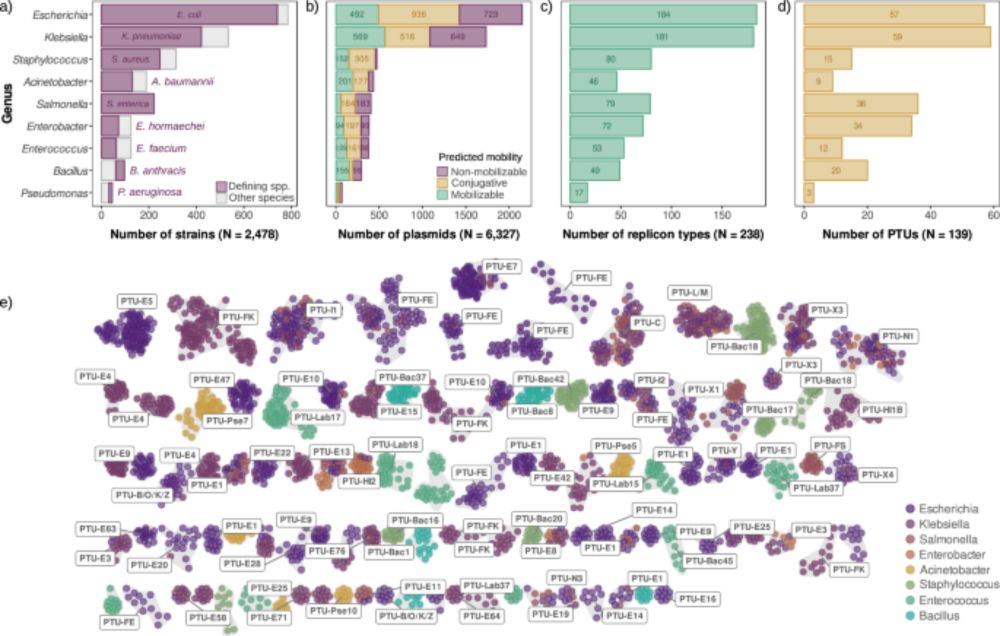
Universal rules govern plasmid copy number - Nature Communications
Plasmids exhibit a broad range of sizes and copies per cell, and these two parameters appear to be negatively correlated. Here, Ramiro-Martínez et al. analyse the copy number of thousands of diverse b...
www.nature.com
July 2, 2025 at 11:08 AM
🚨🚨New paper out in @natcomms.nature.com!!
Come for the first large-scale analysis of plasmid copy number across species,
stay for one of the most intriguing results of my lab: universal scaling laws in plasmid biology! 📈🧬
👉 www.nature.com/articles/s41...
Come for the first large-scale analysis of plasmid copy number across species,
stay for one of the most intriguing results of my lab: universal scaling laws in plasmid biology! 📈🧬
👉 www.nature.com/articles/s41...
Reposted by Alvaro Sanchez
Happy to have this out! Thanks to @asanchezlab.bsky.social and @jacrickets.bsky.social for their mentorship on this project. Below is the thread I previously posted on then-Twitter
Macroecological patterns in experimental microbial communities, led by Will Shoemaker & Jacopo Grilli
journals.plos.org/ploscompbiol...
journals.plos.org/ploscompbiol...
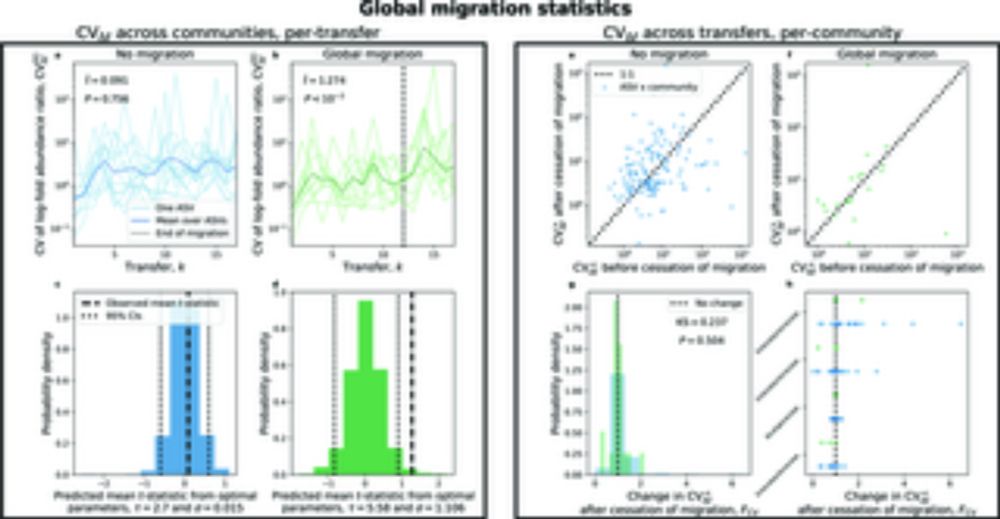
Macroecological patterns in experimental microbial communities
Author summary Determining whether an empirical pattern can be manipulated is a crucial step towards building a predictive theory. Our study aimed to determine the extent that experimental manipulatio...
journals.plos.org
May 27, 2025 at 7:53 PM
Happy to have this out! Thanks to @asanchezlab.bsky.social and @jacrickets.bsky.social for their mentorship on this project. Below is the thread I previously posted on then-Twitter
Macroecological patterns in experimental microbial communities, led by Will Shoemaker & Jacopo Grilli
journals.plos.org/ploscompbiol...
journals.plos.org/ploscompbiol...

Macroecological patterns in experimental microbial communities
Author summary Determining whether an empirical pattern can be manipulated is a crucial step towards building a predictive theory. Our study aimed to determine the extent that experimental manipulatio...
journals.plos.org
May 27, 2025 at 6:23 PM
Macroecological patterns in experimental microbial communities, led by Will Shoemaker & Jacopo Grilli
journals.plos.org/ploscompbiol...
journals.plos.org/ploscompbiol...
Reposted by Alvaro Sanchez
Microbial communities can harbor many species that do not coexist in pairs, yet can coexist in the full community. Here we provide the mathematical foundations of emergent coexistence, and explain why it can't be predicted from pairwise tests www.biorxiv.org/content/10.1...
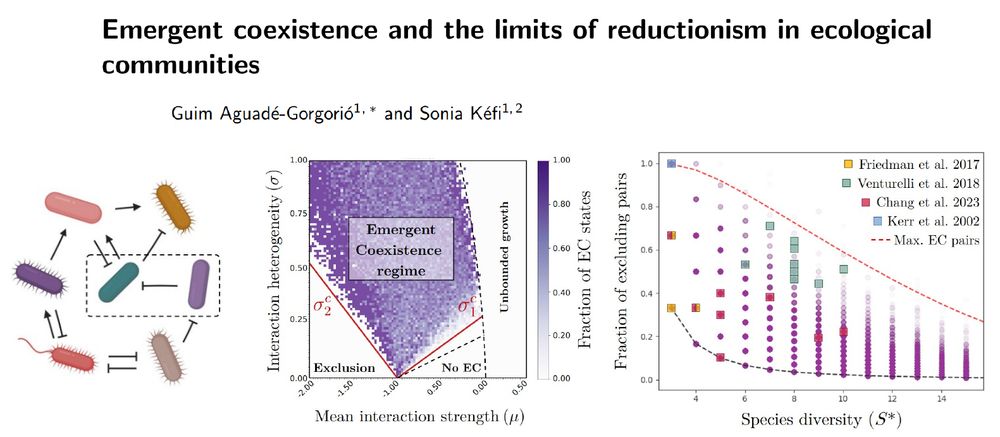
May 20, 2025 at 1:16 PM
Microbial communities can harbor many species that do not coexist in pairs, yet can coexist in the full community. Here we provide the mathematical foundations of emergent coexistence, and explain why it can't be predicted from pairwise tests www.biorxiv.org/content/10.1...
Reposted by Alvaro Sanchez
How can we understand ecosystem dynamics using information theory? Using Shannon's entropy, this paper by Chuliang Song gives a clever introduction to IT within the context of assembly graphs. @longcy.bsky.social @guimaguade.bsky.social @blaividiella.bsky.social
www.clsong.com/assets/pdf/s...
www.clsong.com/assets/pdf/s...

May 10, 2025 at 2:00 PM
How can we understand ecosystem dynamics using information theory? Using Shannon's entropy, this paper by Chuliang Song gives a clever introduction to IT within the context of assembly graphs. @longcy.bsky.social @guimaguade.bsky.social @blaividiella.bsky.social
www.clsong.com/assets/pdf/s...
www.clsong.com/assets/pdf/s...
Reposted by Alvaro Sanchez
🧪
Finally out after peer review, our work showing that "Mobile #Integrons carry Phage Defense Systems" is now published in Science 🎉
Short 🧵
www.science.org/doi/10.1126/...
Finally out after peer review, our work showing that "Mobile #Integrons carry Phage Defense Systems" is now published in Science 🎉
Short 🧵
www.science.org/doi/10.1126/...

Mobile integrons encode phage defense systems
Integrons are bacterial genetic elements that capture, stockpile, and modulate the expression of genes encoded in integron cassettes. Mobile integrons (MIs) are borne on plasmids, acting as a vehicle ...
www.science.org
May 8, 2025 at 8:27 PM
🧪
Finally out after peer review, our work showing that "Mobile #Integrons carry Phage Defense Systems" is now published in Science 🎉
Short 🧵
www.science.org/doi/10.1126/...
Finally out after peer review, our work showing that "Mobile #Integrons carry Phage Defense Systems" is now published in Science 🎉
Short 🧵
www.science.org/doi/10.1126/...
Very neat application of the community-function landscape! Congrats @seppekuehnlab.bsky.social and rest of coauthors!
Third preprint! – We use community-function landscapes to rationally design communities for bioremediation in soils! Spoiler - it works! Led by Mahmoud Yousef, with @kiseokmicro.bsky.social, J. Tang, V. Charisopoulos, B Willett. @nitmb.bsky.social, NSF, MSTP UChicago. www.biorxiv.org/content/10.1...

Collective Microbial Effects Drive Toxin Bioremediation and Enable Rational Design
The metabolic activity of microbial communities is essential for host and environmental health, influencing processes from immune regulation to bioremediation. Given this importance, the rational desi...
www.biorxiv.org
April 1, 2025 at 7:49 AM
Very neat application of the community-function landscape! Congrats @seppekuehnlab.bsky.social and rest of coauthors!
Reposted by Alvaro Sanchez
1/46 Hey folks, we have a new paper out on the MuLTEE. Strap in and I’ll tell you the story of how this “little paper on polyploidy” turned into the most data rich paper our lab has produced, largely thanks to the leadership and work ethic of @kaitong25.bsky.social.
www.nature.com/articles/s41...
www.nature.com/articles/s41...
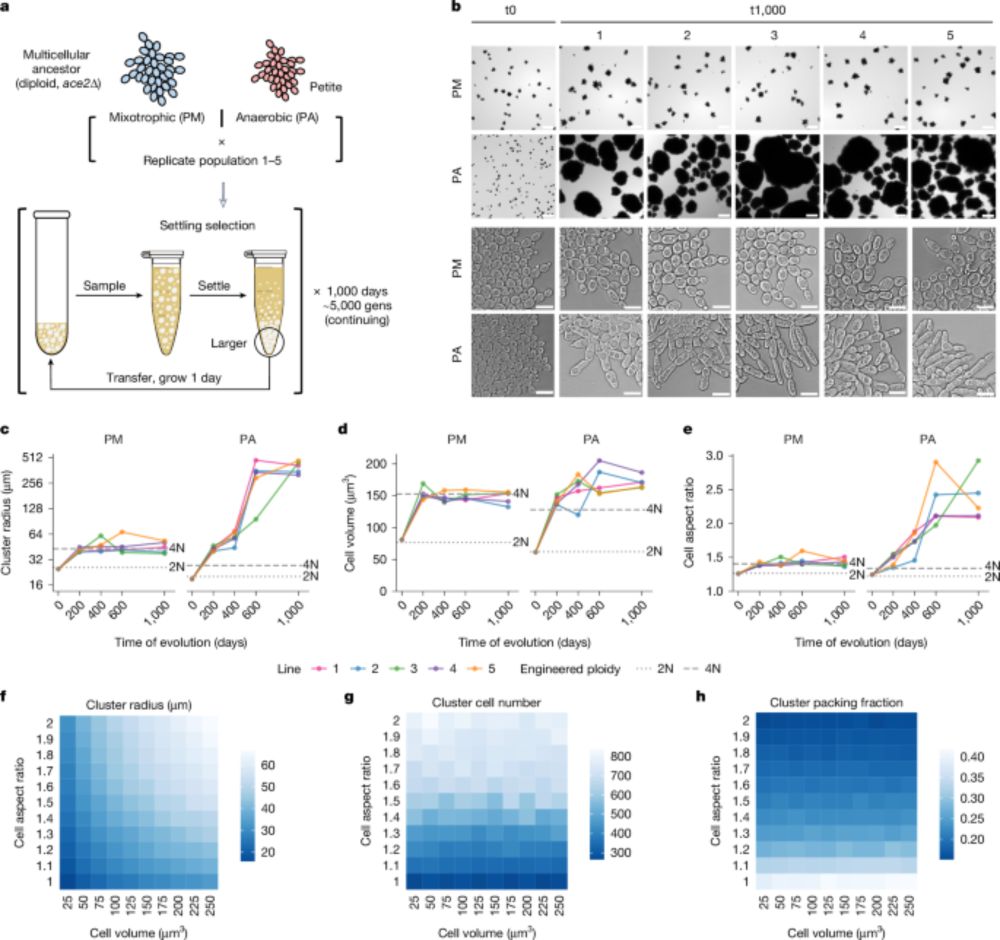
Genome duplication in a long-term multicellularity evolution experiment - Nature
In the Multicellularity Long Term Evolution Experiment, diploid yeast evolve to be tetraploid under selection for larger multicellular size, revealing how whole-genome duplication can arise due to its...
www.nature.com
March 5, 2025 at 11:00 PM
1/46 Hey folks, we have a new paper out on the MuLTEE. Strap in and I’ll tell you the story of how this “little paper on polyploidy” turned into the most data rich paper our lab has produced, largely thanks to the leadership and work ethic of @kaitong25.bsky.social.
www.nature.com/articles/s41...
www.nature.com/articles/s41...
Reposted by Alvaro Sanchez
Lovely paper. The bug we work on, Neisseria gonorrhoeae, has *hundreds* of genes that can phase-vary (stochastically switch on and off), to allow immune evasion and adaptation to different niches within and between hosts. 1/

Experimental evolution of evolvability
Evolvability—the capacity to generate adaptive variation—is a trait that can itself evolve through natural selection. However, the idea that mutation can become biased toward adaptive outcomes remains...
www.science.org
February 21, 2025 at 7:28 AM
Lovely paper. The bug we work on, Neisseria gonorrhoeae, has *hundreds* of genes that can phase-vary (stochastically switch on and off), to allow immune evasion and adaptation to different niches within and between hosts. 1/
Reposted by Alvaro Sanchez
In the literature of domestication and microbiomes there seems to be the expectation that: domestication should lead to the loss of microbiome diversity and host-control. Alejandra Hernandez-Teran and I were both skeptical of both, so we decided to see what we know so far (1/6)
shorturl.at/FHY9H
shorturl.at/FHY9H

Plant domestication does not reduce diversity in root microbiomes
Domestication has profoundly shaped human civilization and the genetic makeup of numerous plant and animal species. While the effects of plant domestication at the genetic and phenotypic levels are well-documented, its impact on plant microbiome remains less understood. Root microbiomes play crucial roles in nutrient acquisition, pathogen defense, and biotic stress tolerance, yet the influence of domestication on their diversity and assembly is still debated. Two primary hypotheses have been proposed: 1) the reduction in microbial diversity resulting from the domestication process, and 2) the diminished ability of host plants to control their microbiomes. To evaluate these hypotheses, we conducted a meta-analysis of multiple crops, comparing the root microbiomes of domesticated plants and their wild relatives. Our results indicate that the effects of domestication are species-specific and context-dependent, with most domesticated plants exhibiting increased microbial diversity and more structured communities, while others show no significant change. Overall, this study provides evidence that plant domestication does not lead to a uniform reduction in microbial diversity or a consistently diminished ability of plants to influence their microbiomes. Based on these findings, we discuss new perspectives and the need for future studies incorporating native soils and host genetic variation in such experiments, analyzing not only diversity but also microbiome function, and considering how root morphology might affect microbiome recruitment. Finally, we highlight the need for research on the potential adaptive or maladaptive consequences that introgression between wild and domesticated plants could have from a microbiome perspective. ### Competing Interest Statement The authors have declared no competing interest.
doi.org
January 18, 2025 at 1:44 AM
In the literature of domestication and microbiomes there seems to be the expectation that: domestication should lead to the loss of microbiome diversity and host-control. Alejandra Hernandez-Teran and I were both skeptical of both, so we decided to see what we know so far (1/6)
shorturl.at/FHY9H
shorturl.at/FHY9H

